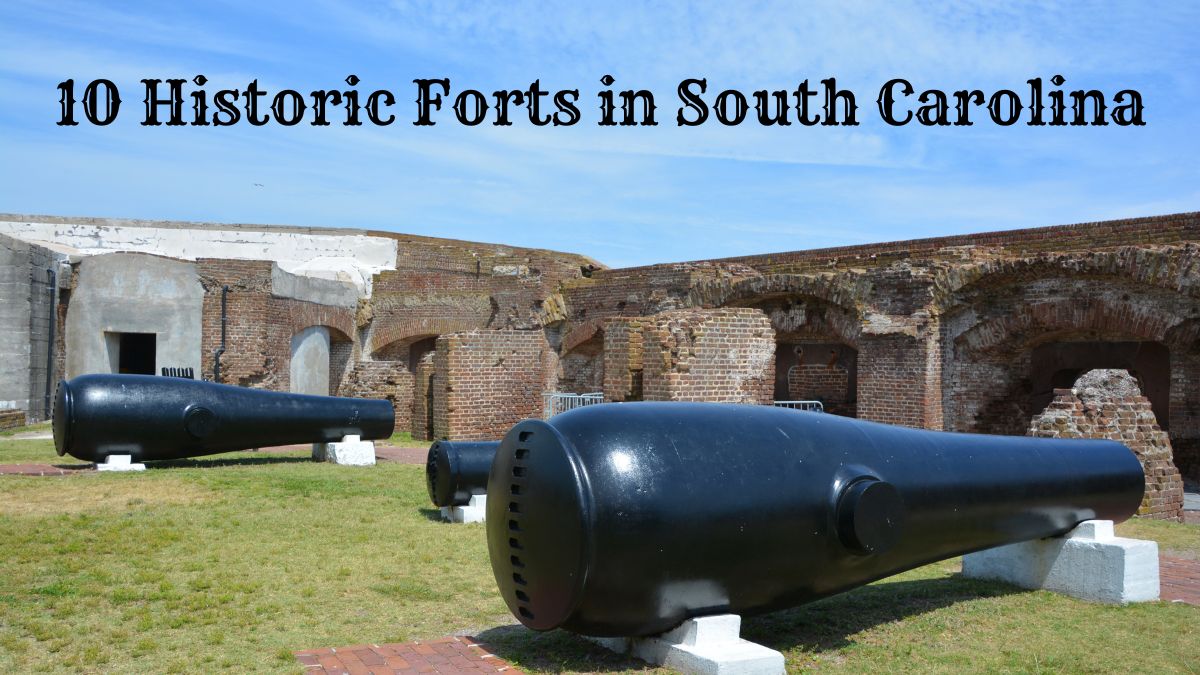South Carolina, a state with a rich history deeply interwoven with the tapestry of American history, boasts many historic sites.
From the Savannah River to Charleston Harbor, this Palmetto State has a long-standing legacy of forts, many of which have been preserved by the National Park Service.
In this article, historic forts in South Carolina, we traverse the historic trails of these fortifications, understanding their roles in various wars, their architectural brilliance, and their present-day significance.
10 Historic Forts in South Carolina
| 1. Fort Jackson | 6. Fort Fremont |
| 2. Fort Sumter | 7. Fort Johnson |
| 3. Fort Sullivan | 8. Castle Pinckney |
| 4. Fort Mitchell | 9. Fort Lamar |
| 5. Fort Wagner | 10. Fort Prince George |
1. Fort Jackson
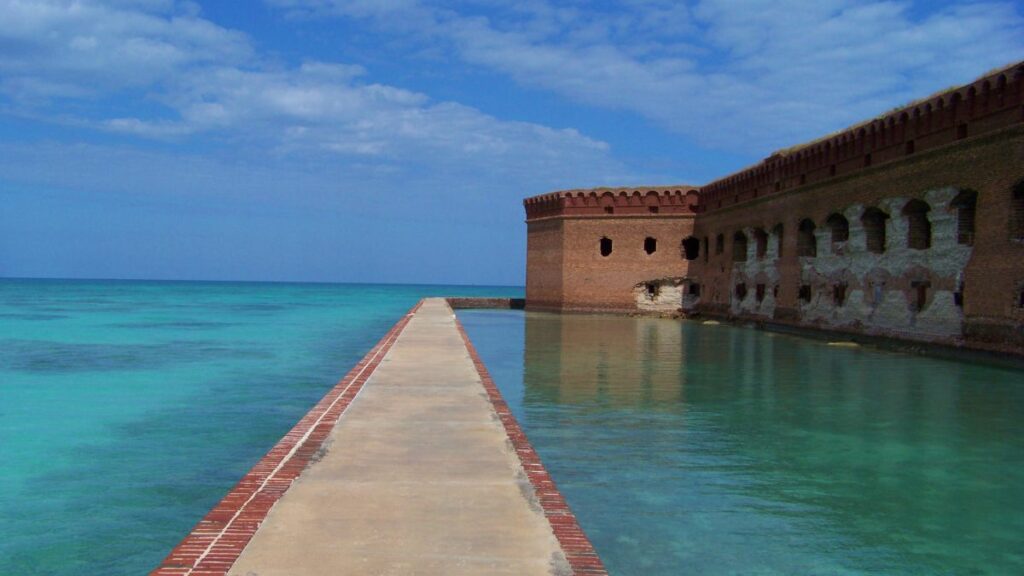
Amid World War I, as the United States grappled with the realities of a global conflict, a need arose for more military bases to prepare its soldiers for the demanding theater of war.
Thus, in 1917, Fort Jackson was established. Named in tribute to the revered U.S. Army General Andrew Jackson, a native South Carolinian who later ascended to the presidency, this establishment soon became a cornerstone of military training.
The Crucible of World War II: 1940s
As the clouds of World War II gathered, Fort Jackson’s role gained newfound prominence. Under the leadership of various commanders, including Major General John K. Herr, who took command in 1940, the base transformed into a hub of military activity.
Throughout the 1940s, it was a pivotal training ground, churning out legions of troops who would later tread the battlefields of Europe and the Pacific.
Adapting to Changing Times: Korean and Vietnam Wars
The subsequent decades saw Fort Jackson play a vital role during the Korean War (1950-1953) and the Vietnam War (1965-1973). Commanders like Brigadier General George C. Morton in the early 1960s ensured that the training programs evolved to meet the unique challenges of each conflict.
The fort was not just a training ground but a place where strategy and adaptation converged, preparing soldiers for the diverse terrains and challenges of foreign lands.
Reflections on a Storied Past
Looking back, Fort Jackson’s historical significance is not merely rooted in its impressive size or current role as a primary center for Basic Combat Training. Its essence lies in its storied past, its adaptation through various eras of conflict, and the countless soldiers and leaders who have walked its grounds.
Fort Jackson is a tangible testament to America’s military evolution from its inception in 1917 to its vital role through two World Wars and other conflicts.
2. Fort Sumter
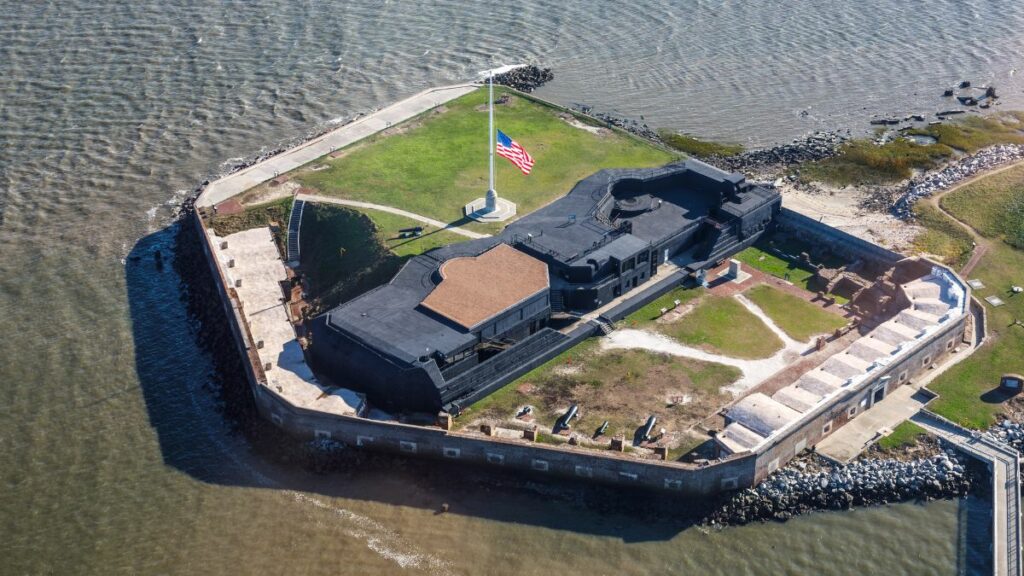
Fort Sumter, strategically positioned on an island in Charleston Harbor, was envisioned as part of a series of coastal fortifications following the War of 1812. Its construction began in 1829.
By the late 1850s, the fort was nearly complete under the direction of then-Major Robert Anderson. It stood a testament to American architectural and military prowess, ready to defend the harbor.
The Outbreak of Conflict: April 12, 1861
As national tensions over slavery and states’ rights reached a boiling point, Fort Sumter emerged as a symbolic battleground. On April 12, 1861, Confederate forces under General P.G.T. Beauregard fired the first shots of the American Civil War on the fort, making Fort Sumter’s name forever synonymous with the war’s beginning.
With a limited supply line and faced with relentless Confederate bombardment, Major Anderson surrendered the fort on April 14, 1861. This event not only marked the start of the Civil War but also set the tone for the intense conflict that would follow.
Throughout the Civil War: 1861-1865
Fort Sumter witnessed relentless skirmishes and exchanges between Confederate and Union forces throughout the war. The Confederate army maintained control of the fort for nearly the entirety of the war, enduring Union attempts to retake this critical point.
It wasn’t until February 1865, with the Confederacy’s decline, that Union forces, led by General William Tecumseh Sherman during his march through the South, successfully regained control of the fort.
Echoes from the Past: Preservation and Memory
Today, Fort Sumter is a potent symbol of the nation’s internal strife and the path to reunification. Designated a National Monument in 1948, it remains a place of reflection, education, and remembrance, drawing visitors keen to understand the profound impacts of the Civil War on American history.
The fort’s walls, scarred by artillery fire, and its flag, symbolic of resilience, speak volumes about the nation’s tumultuous journey toward unity.
3. Fort Sullivan
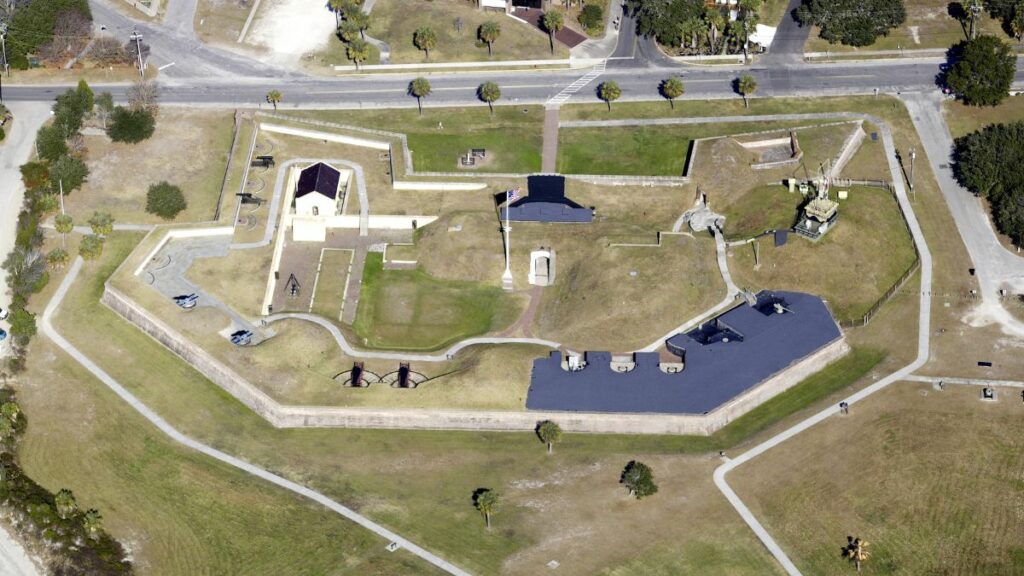
Located on Sullivan’s Island, at the entrance of Charleston Harbor, Fort Sullivan emerged as a strategic bastion during America’s fight for independence. Recognizing the need to defend the crucial port city of Charleston from potential British incursions, colonial leaders began the construction of this sea fort in the 1770s.
The Triumph of Palmetto Logs: June 28, 1776
In the early days of the American Revolutionary War, the British fleet, keen on capturing the Southern colonies, set its sights on Charleston. On June 28, 1776, British warships bombarded Fort Sullivan. However, under the leadership of Colonel William Moultrie, the fort’s defenders displayed exemplary resilience.
Notably, the fort’s walls, made of palmetto logs, absorbed and repelled the British cannonballs, preventing significant damage. The tenacity of the American defenders led to a pivotal colonial victory, with the British fleet eventually withdrawing. In honor of Moultrie’s leadership, the fort was later renamed Fort Moultrie.
A Witness to Changing Times
Over the years, Fort Sullivan, or Fort Moultrie as it became more commonly known, played various roles in America’s defensive strategy. It was rebuilt and modernized multiple times, serving in subsequent conflicts like the Civil War.
The fort bore witness to changing technologies and shifting battle tactics, transitioning from its humble palmetto log beginnings to a more modernized fortification.
From Historical Ground to National Recognition
Today, Fort Sullivan, remembered more popularly as Fort Moultrie, is a testament to American ingenuity, resilience, and the enduring spirit of freedom. Designated as part of the Fort Sumter National Monument in the 20th century, it attracts history enthusiasts, scholars, and visitors.
The fort serves as a living narrative of America’s journey from a colony to a nation, ensuring that the bravery of figures like William Moultrie and his men remains etched in the annals of time.
4. Fort Mitchel
Situated on Hilton Head Island in South Carolina, Fort Mitchel is a reminder of the island’s military significance during the Civil War. With its strategic location along the coast, Hilton Head became a focal point for the Union and Confederate forces.
Recognizing the need to bolster defenses and maintain control of the island, the Union Army constructed Fort Mitchell after successfully capturing Hilton Head in November 1861.
Role in the Southern Theater: 1861-1865
Throughout the Civil War, Fort Mitchel and other fortifications on the island served as a key defensive position for the Union forces. The fort, with its artillery placements, helped ensure the security of the Port Royal Sound, a crucial naval route for the Union Army and Navy.
As the war progressed, Hilton Head Island became a base for Union operations in the Southern theater, making the defenses at Fort Mitchell vital for protecting the island against potential Confederate counter-offensives.
Legacy in Preservation
Post-war, as the military importance of Hilton Head Island diminished, Fort Mitchel, like many other wartime fortifications, was abandoned. Over time, the elements and nature reclaimed portions of the fort.
However, recognizing the historical value of such sites, efforts have been made in recent decades to preserve and interpret Fort Mitchel for visitors. Today, it stands as a testament to Hilton Head Island’s role during the Civil War and offers a glimpse into the military strategies and challenges of the period.
For those interested in the Civil War’s Southern campaigns and the intricate tapestry of coastal defenses, Fort Mitchel offers a unique window into the past, a tangible link to a pivotal era in American history.
5. Fort Wagner

Located on Morris Island in Charleston Harbor, South Carolina, Fort Wagner was part of the Confederacy’s intricate coastal defenses. Constructed in 1863, this earthen fort was designed to guard the southern approach to Charleston, a city of immense strategic and symbolic importance during the American Civil War.
The Siege and The 54th Massachusetts: July 18, 1863
One of Fort Wagner’s most historically significant events was the intense battle fought on July 18, 1863. Union forces, seeking to capture Charleston, launched a determined assault on the fort.
The attack was spearheaded by the 54th Massachusetts Volunteer Infantry, one of the first major American military units comprised of Black soldiers during the Civil War.
Under the leadership of Colonel Robert Gould Shaw, these troops showcased remarkable courage against entrenched Confederate defenses.
Despite their valiant efforts, the Union forces were repelled. However, the bravery of the 54th Massachusetts left an indelible mark on American history, highlighting the role and sacrifice of Black soldiers in the war for the Union.
The Fall of Fort Wagner: September 1863
While the July assault was unsuccessful, continuous bombardments and sieges weakened the Confederate hold on Fort Wagner. By September 1863, deteriorating conditions and a relentless Union siege forced Confederate troops to abandon the fort, marking a turning point in the Union’s campaign to capture Charleston.
An Emblem of Sacrifice and Courage
Today, Fort Wagner is remembered as a military stronghold and a symbol of bravery, sacrifice, and the quest for freedom and equality.
The actions of the 54th Massachusetts and other Union troops during the siege have been immortalized in art, literature, and films, ensuring that the legacy of Fort Wagner and its defenders endures for future generations. The fort is a testament to the Civil War’s complexities and the individuals who shaped its outcome.
6. Fort Fremont
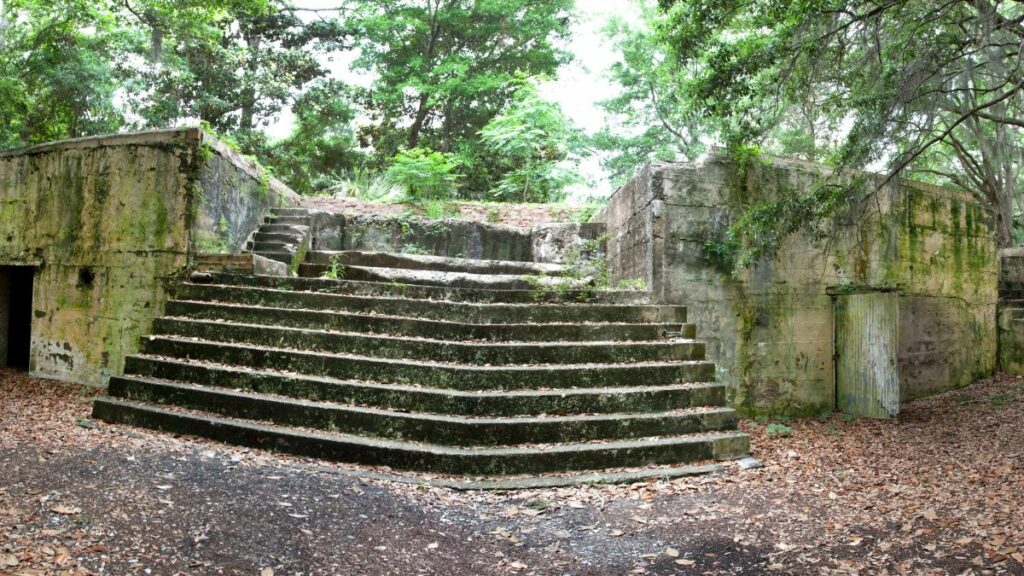
Constructed on Saint Helena Island in South Carolina, Fort Fremont became part of the United States’ broader coastal defense strategy.
The Spanish-American War of 1898 highlighted potential vulnerabilities along the American coastline. In response, the U.S. government initiated the construction of Fort Fremont in 1899 to protect the vital Port Royal Sound and its naval facilities.
Architectural Feats and Military Deployment: 1900s
Fort Fremont was designed with the cutting-edge military architecture of its time. It boasted powerful coastal artillery guns strategically positioned to deter potential naval threats.
When operational, the fort was garrisoned by approximately 110 soldiers, with infrastructure that included barracks, a hospital, and various support buildings. Its strategic placement and formidable design made it a linchpin in defending the southeastern American coastline.
Transition and the World Wars
As military technology and strategies evolved, particularly with the advent of airpower and larger naval vessels, many coastal defenses, including Fort Fremont, faced obsolescence.
Though it never saw combat, the fort served as a sentinel during World War I and II. After the Second World War, the military’s focus shifted away from these traditional coastal defenses, leading to the decommissioning and abandonment of many such installations.
Preservation and Present-day Significance
Conservation efforts were initiated in the latter half of the 20th century, recognizing Fort Fremont’s historical significance. Today, it is a reminder of a bygone era of military strategy and architecture.
The Fort Fremont Historical Park preserves this historic site, offering visitors a glimpse into the past and the ever-evolving nature of military defense tactics.
The legacy of Fort Fremont is intricately woven into the tapestry of America’s military history, showcasing a period of rapid technological advancement and the nation’s commitment to safeguarding its shores.
7. Fort Johnson

Located strategically on James Island in Charleston Harbor, South Carolina, Fort Johnson has seen various iterations since its inception. Established in the late 1600s, it was named in honor of Sir Nathaniel Johnson, the then-proprietary Governor of Carolina.
The fort was conceived in response to growing threats from pirates, foreign invaders, and Native American tribes, serving as a bulwark against potential incursions into the flourishing city of Charleston.
The Prelude to Revolution: Mid-18th Century
In the years leading up to the American Revolutionary War, tensions between the colonies and the British Crown reached a fever pitch. Fort Johnson became embroiled in these events in 1765 when it served as a focal point of protest against the Stamp Act.
Its significance was underscored when the British Crown reinforced the fort to exert control over the increasingly rebellious colony.
A Flashpoint of the Civil War: April 12, 1861
Arguably, Fort Johnson’s most historically significant moment came in the early hours of the American Civil War. On April 12, 1861, it was from this very fort that Confederate forces fired the first shots at Fort Sumter, marking the commencement of the bloodiest conflict in American history.
This act firmly positioned Fort Johnson at the epicenter of the nation’s internal struggle over states’ rights and the institution of slavery.
Post-War Evolution and Present Day
After the Civil War, Fort Johnson underwent various modifications, reflecting the evolving defense needs of the nation. By the 20th century, the fort transitioned to more scientific endeavors, housing marine science research institutions.
Today, parts of the fort are utilized by the South Carolina Department of Natural Resources and the College of Charleston for marine research, merging its rich history with the promise of scientific discovery.
Fort Johnson remains a potent symbol of America’s tumultuous past, a witness to the nation’s evolving history from colonial times through the Civil War and beyond. Today, it is a testament to its strategic military importance and a beacon of academic and research excellence.
8. Castle Pinckney
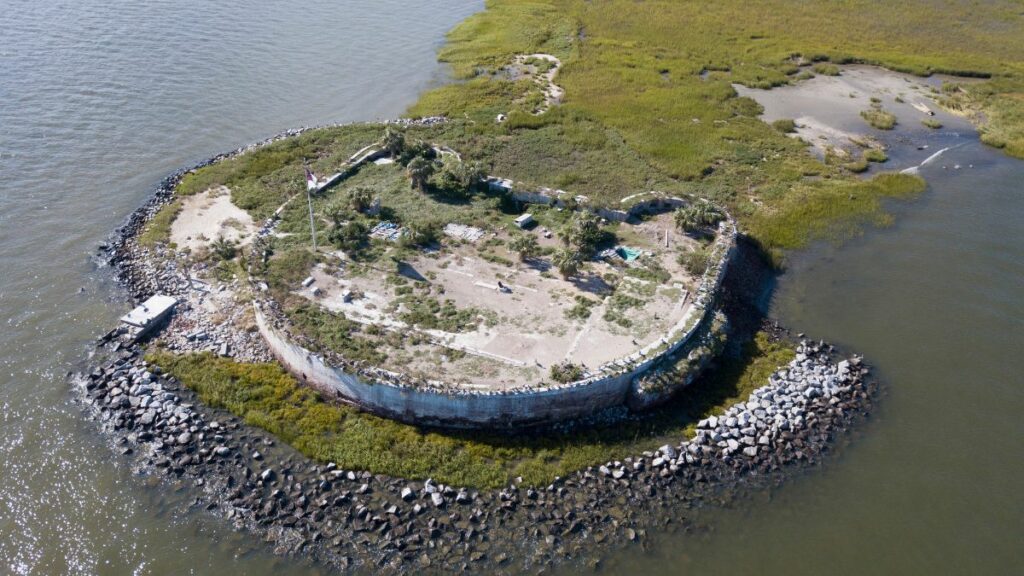
Situated on a small artificial island within the Charleston Harbor of South Carolina, Castle Pinckney began its life in the early 1800s.
Originally constructed as a coastal defense for the young United States, it was designed to protect one of the nation’s most vital and bustling ports, Charleston. Its name, “Castle,” signified its primary role as a stronghold rather than a typical military fort.
Construction and Architectural Feats: 1808-1810
Castle Pinckney’s initial construction occurred between 1808 and 1810. Built on the foundation of an older fortification, the fort represented the architectural and military thinking of its time, incorporating high walls, gun embrasures, and a traditional “star fort” design to fend off naval threats.
The Echoes of Civil War: 1861
With the onset of the American Civil War, Castle Pinckney took on renewed significance. Seized by Confederate forces in December 1860, it became a Confederate stronghold shortly after South Carolina’s secession.
While it did not witness combat on the scale of nearby Fort Sumter, Castle Pinckney held Union prisoners for a time and functioned as a symbolic representation of Confederate defiance.
Decline and Preservation: 20th Century to Present
As military technologies and strategies evolved, Castle Pinckney fell into obsolescence like many coastal defenses of its era. While briefly revived during World War I and II as a coastal artillery station, the fort eventually faced abandonment.
Recognizing its historical value, efforts have been made to preserve this relic of American history. 1970 Castle Pinckney was added to the National Register of Historic Places.
Today, Castle Pinckney is a silent guardian of Charleston Harbor‘s history, echoing tales of early American defense strategies, Civil War tensions, and the passage of time. Its walls, which have witnessed both military drills and the march of history, beckon visitors to delve deep into the annals of the Palmetto State and the nation.
9. Fort Lamar
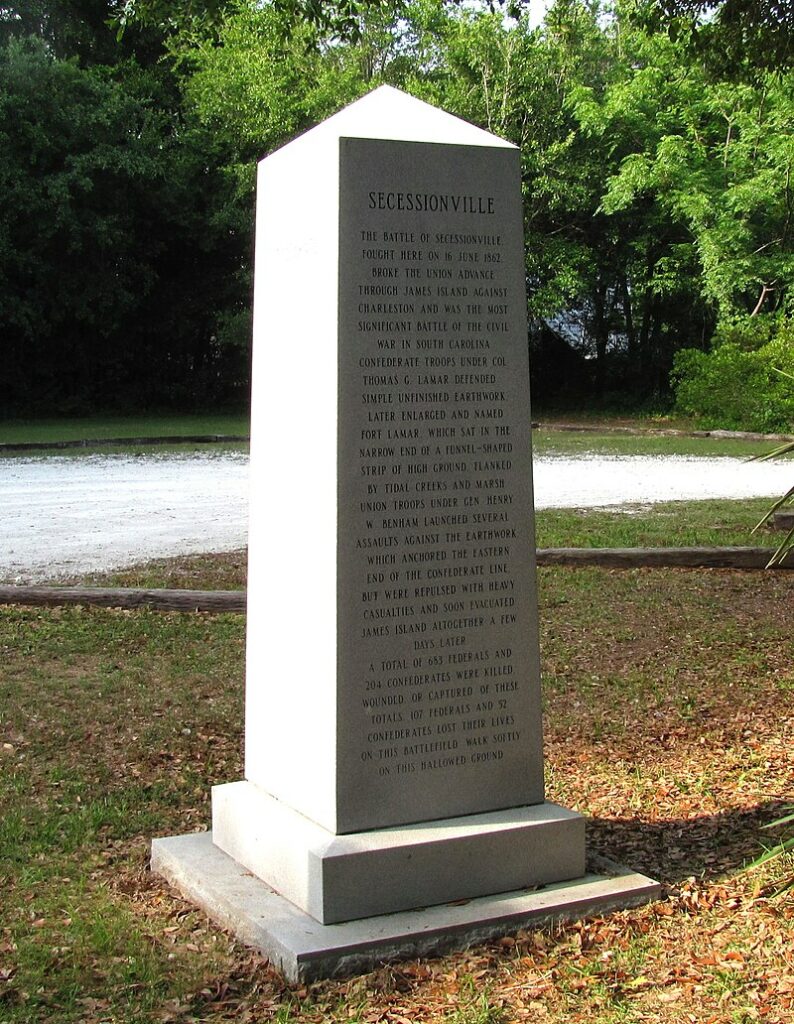
Nestled within James Island, South Carolina, Fort Lamar arose amidst the turbulence of the American Civil War. In 1862, as Union forces sought to capture the city of Charleston, Confederate troops hastily constructed this earthen fortification.
The fort, originally named “Fort Secession,” was strategically positioned to shield Charleston from a Union advance.
The Battle of Secessionville: June 16, 1862
Fort Lamar’s place in history is firmly cemented by the Battle of Secessionville on June 16, 1862. Early that morning, Union brigades launched an assault on the fort. Confederate troops, heavily outnumbered, mounted a fierce defense.
With high walls and a strategic layout, the fort gave the Confederates a significant advantage, enabling them to repel the Union attack despite being heavily outnumbered. This Confederate victory at Fort Lamar was pivotal, as it halted Union advances on Charleston for nearly two more years.
Significance and Legacy
The Battle of Secessionville and Fort Lamar’s defense was crucial in prolonging Charleston’s resistance against Union occupation. The city, rich in symbolism and strategic value, remained in Confederate hands until the war’s final months.
Preservation and Modern Importance
Recognizing its significance in the tapestry of American history, efforts were made to preserve the site. Today, the area surrounding Fort Lamar has been designated as the Secessionville Historic District.
The remnants of the fort and the battlefield serve as poignant reminders of the struggles faced during the Civil War. Visitors to the site can walk in the footsteps of soldiers, absorbing the tales of courage and sacrifice that Fort Lamar silently narrates.
In a landscape replete with Civil War memories, Fort Lamar stands out for its testament to the resilience and tactical prowess of the Confederate defense, offering history enthusiasts a deep dive into a pivotal moment in the nation’s most defining conflict.
10. Fort Prince George
Nestled on the banks of the Keowee River in present-day Pickens County, South Carolina, Fort Prince George was established in 1753. Built by British colonialists, the fort was a strategic response to the encroaching French influence in the Ohio Valley and to protect British interests against growing European territorial ambitions in North America.
The Cherokee Alliance and Diplomacy: 1750s
In the mid-18th century, the British sought alliances with Native American tribes, notably the Cherokee, to bolster their colonial hold.
Fort Prince George played a pivotal role in this diplomacy, serving as a trading post, negotiation site, and point of interaction between the British and the Cherokee. However, tensions between the two sides were never far from the surface.
A Flashpoint of Tensions: 1760
The uneasy alliance took a tragic turn in 1760. Amidst rising tensions over land encroachments and perceived slights, Cherokee leaders were imprisoned within Fort Prince George.
A skirmish ensued, leading to the death of several Cherokee chiefs and the fort’s commander, Lt. Richard Coytmore. This incident further strained relations and ignited the Anglo-Cherokee War, which raged from 1760 to 1761.
Aftermath and Legacy
Following the conflict, Fort Prince George lost its significance. The fort fell into disrepair with the Cherokee driven further west and British attention toward coastal defenses.
However, its historical implications lingered. The fort’s events underscored the complex interplay between colonial and indigenous interests in the Americas.
Preservation and Today
The original Fort Prince George no longer stands, but the site remains an important archaeological and historical landmark. Commemorative efforts have led to constructing a replica fort nearby, allowing visitors to immerse themselves in the colonial past.
The fort and its stories offer a window into early American colonialism, Native American relations, and the tumultuous path leading to the formation of the United States.
Related: Army Forts in South Carolina
Visiting Historic Forts in South Carolina
South Carolina’s historic forts are living testaments to the nation’s rich tapestry of history, wars, and cultural shifts.
Many of these forts, such as Fort Moultrie on Sullivan’s Island, have been duly recognized for their historical significance. They are either encompassed within the national parks system or proudly listed on the National Register of Historic Places.
Immersive Visitor Centers
Visitor centers, like the one at Pickens County, serve as gateways to the past for those yearning to delve deeper into the annals of American history.
These centers often have interactive exhibits, meticulously curated artifacts, and knowledgeable staff ready to guide visitors through the epochs. From the first moments of colonial resistance to the intense drama of the Civil Wars, these centers offer comprehensive insights into the events that unfolded within the fort walls.
Access for All
In the spirit of promoting history and ensuring it remains accessible to all, several of these historic sites and forts have taken commendable steps.
Notably, some locations offer free admission, ensuring financial constraints do not hinder passionate history buffs or families looking to educate their young ones about the nation’s heritage. Such gestures amplify the importance of remembering and learning from the past.
A Call to History Enthusiasts
Whether you’re a dedicated history enthusiast, a student eager to see textbook lessons come to life, or simply someone curious about America’s past, these forts stand as inviting portals to a bygone era.
With their majestic walls, evocative exhibits, and the echoes of centuries past, a visit promises both education and reflection on the events that have shaped the nation.

Cory is a website owner and content creator who enjoys fishing, history, coin collecting, and sports, among other hobbies. He is a husband and father of four.
Romans 15:4 For whatever was written in former days was written for our instruction, that through endurance and through the encouragement of the Scriptures we might have hope.

